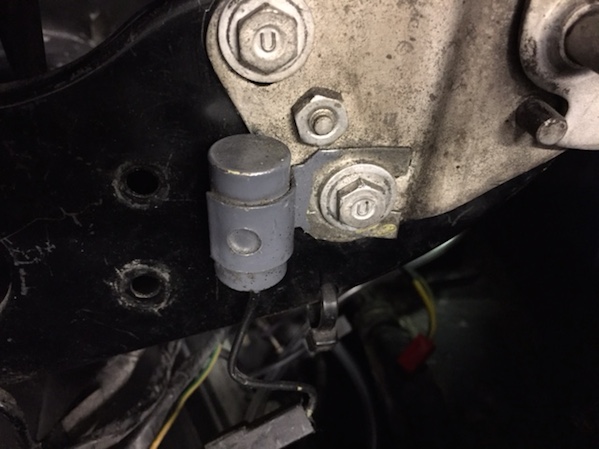| Author | Message | ||
Jean-Pierre 'JP' Hilbert Frequent User Username: jphilbert Post Number: 85 Registered: 9-2013 |
Gents, Since I got the car 2 years ago, there was never much air coming out of the vents. AC works fine to the tune that one can hang meat inside the car. Heater too. However, I'm missing the flux of air, the hurricane other Perfect Motor Cars produce with the fans on high. My investigation produced 2 sources of problems: i) the cover of the AC evaporator, severely pitted and cracked, to the tune that most of the air from the fans must have ended up in the engine bay and thus contributed to the cooling of the six-three-quarters. I repaired with fibreglass; and ii) voltage to the fans: at LOW setting, voltage to the fans is 3,5V. At HIGH setting, it is 7,2V. Having taken care of problem i), Im asking for kind info whether the voltages to the fans should really be that low. Maybe hopefully possibly one forum member could run their engine and measure the voltages to their fans (simply unplug the 2 leads and stick voltmeter ends into the wire plugs). Also, what is that switch that looks like a proximity switch from an airplane? TSD 4400 says it is a valance earth switch. What does it do? Then, speaking about TSD 4400, I hope that the engineer who came up with that system got knighted by the Queen. It is beyond somebody who has other things to do than study this. This should be understood as an apology to anybody feeling offended that I launch a question which may be answered by studying the workshop manual. In a nutshell, why do I only get a maxim of 7V to the fans?  | ||
Jean-Pierre 'JP' Hilbert Frequent User Username: jphilbert Post Number: 86 Registered: 9-2013 |
btw, attached some pics of the pitted/cracked evaporator box... tried to obtain another one from the usual breakers but they are all pitted, seems to be a(nother) design mistake...    | ||
David Gore Moderator Username: david_gore Post Number: 1664 Registered: 4-2003 |
Hi J-P, To keep your images underneath each other to avoid having to scroll across the page to see them, just hit the ENTER key twice after the closing bracket for each IMAGE command. Regards David | ||
Jean-Pierre 'JP' Hilbert Frequent User Username: jphilbert Post Number: 87 Registered: 9-2013 |
David, Copied, received with thanks...still, the pics on my post look fine on my MAC (designed in California, assembled in china). What about fan voltage? | ||
Robert Noel Reddington Prolific User Username: bob_uk Post Number: 199 Registered: 5-2015 |
The fans on my Shadow are gale force when flat out. The speed of the fans is contolled by putting 3 resistors in a combination of series and parallel. series being low speed parallel faster and no resistors in circuit flat out. In other words 14.4 Volts with engine running. The resistors on a Shadow are mounted on the left hand inner wing by the aircon filter dryer. Some cars all makes, mount the resistors inside the heater box so that the fans blow air over the resistors to cool the resistors. Find the resistors and check with ohm meter. Because of the amount of amps these resistors are coils of wire. I have heard this wire called eureka wire. I am afraid to understand the resistance circuit the wiring diagram will be needed The pitting isn't a design fault as such its just old age. The electrical device bolted to the suspension turret top. Looks like a Radio interference suppression capacitor. | ||
Jean-Pierre 'JP' Hilbert Frequent User Username: jphilbert Post Number: 88 Registered: 9-2013 |
Bob, Good direction you point me, but nothing much on the left fender (pic). There are 3 relays. There were no resistors inside the heater box (had it apart last week). There is a relay ''fan speed module'' under the steering wheel, hence I believe that the fan speed is controlled by such a 'module''. Do you get 14V to your fans if selector in HIGH position?  | ||
Robert Noel Reddington Prolific User Username: bob_uk Post Number: 207 Registered: 5-2015 |
The speed control module is probably a pulse width device. It turns the volts to the fans on and off fast. If the off time is the same as the on time then the fans see the voltage as 50% and so on. Check continuity between module and fan speed switch. Do check the drivers hand book to make sure one is operating the system correctly. Also the theoretical wiring diagram. Pulse Width Modulation PWM. Is more efficient than resistors because no heat is lost to resistances. My system of three large disk type resistors consume the same amount of amps regardless of fan speed. I am uncertain about last statement. Help required from the electronics guys. Fans use a fair bit of amps. The PWM system uses much less amps when the fans are going slow. And the same amount when flat out as a Shadow. One advantage of the Shadow system is no electronics and wire wound resistors can easily be rewound by hand using eureka wire from old domestic electric heaters elements. The power consumption of resistor speed control isn't a problem because the alternator has enough grunt to cover it and some more. |